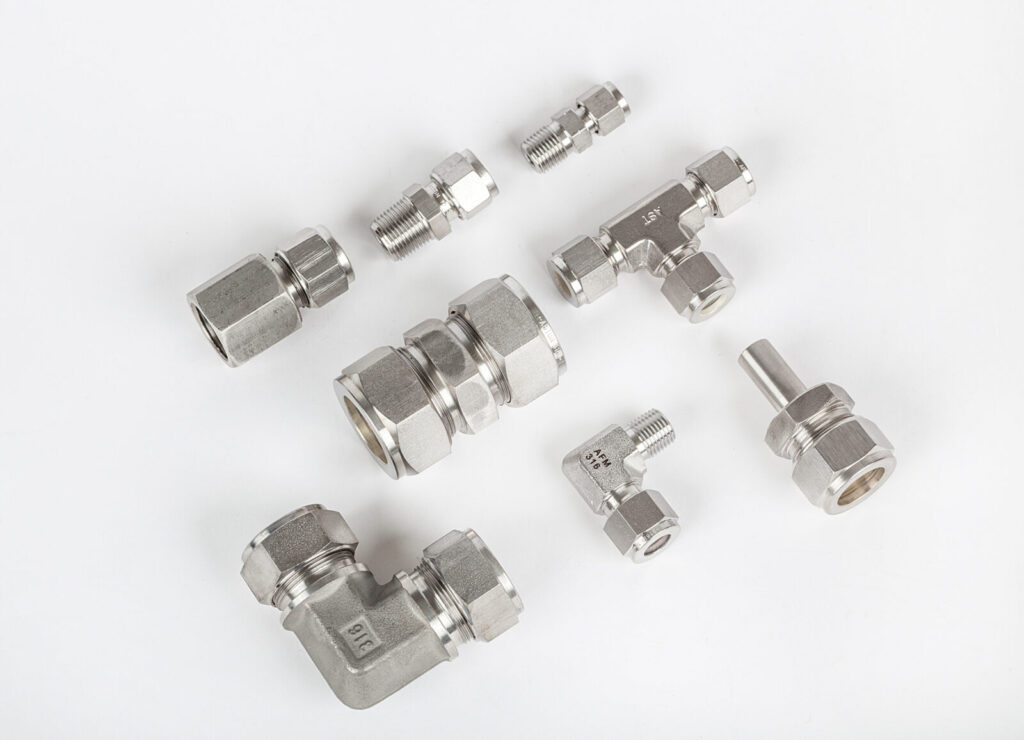Twin Ferrule Compression Fittings: Uses, Benefits, & Comparisons
When it comes to creating secure, leak-proof connections in fluid and gas systems, twin ferrule compression fittings stand out as a reliable choice. These fittings are crucial in various industrial applications, ensuring robust and reliable connections.
Explore what twin ferrule compression fittings are, their uses, why they are needed, how they are used, and which one is best for your project.

What Are Twin Ferrule Compression Fittings?
Twin ferrule compression fittings are mechanical connectors used to join two tubes or thin-walled pipes. They consist of four main components: a nut, a front ferrule, a back ferrule, and the fitting body. The twin ferrule system is designed to provide a strong, leak-tight connection without the need for welding or soldering.
This makes them especially useful in applications where heat cannot be applied or in systems that require frequent disassembly and reassembly.
Uses of Twin Ferrule Compression Fittings
Twin ferrule compression fittings are widely used across various industries, including:
- Chemical Processing: To handle corrosive chemicals and ensure leak-proof connections.
- Oil and Gas: For high-pressure applications and to manage the safe transport of hazardous substances.
- Pharmaceuticals: Ensuring sterile and contaminant-free connections.
- Food and Beverage: To maintain sanitary conditions and prevent contamination.
- Pneumatics and Hydraulics: For efficient fluid power systems requiring high reliability.
- Laboratories: Where precise, leak-free connections are crucial.
Why Are Twin Ferrule Compression Fittings Needed?
Leak Prevention
One of the primary reasons twin ferrule compression fittings are needed is their exceptional ability to prevent leaks. The two ferrules work in tandem to form a tight seal around the tube. The front ferrule forms a primary seal on the tube and against the fitting body, while the back ferrule grips the tube to hold it securely in place.
Ease of Installation
Twin ferrule compression fittings are relatively easy to install compared to other types of fittings. They do not require special tools or expertise, which makes them suitable for field installations. This ease of use translates to reduced downtime and lower labour costs.
Versatility
These fittings can be used with various types of tubing materials, including stainless steel, copper, and plastic, providing flexibility in different applications. Their ability to handle high pressures and temperatures makes them versatile for many industrial environments.
Reusability
Another significant advantage is their reusability. Twin ferrule compression fittings can be disconnected and reconnected multiple times without compromising the integrity of the connection. This feature is particularly beneficial in maintenance-intensive industries.
Twin Ferrule vs. Single Ferrule Compression Fittings
Design Differences
- Twin Ferrule: As the name suggests, twin ferrule compression fittings use two ferrules – a front and a back ferrule. The front ferrule creates a seal with the fitting body, while the back ferrule secures the tube.
- Single Ferrule: Single ferrule fittings use only one ferrule, which both seals and grips the tube.
Performance
Twin ferrule fittings generally provide a more reliable and robust seal, especially in high-pressure applications. The dual-ferrule system allows for better compensation for tube irregularities and variations in hardness, ensuring a more consistent seal.
Installation and Reusability
Twin ferrule fittings are often considered easier to install correctly and are more forgiving during reassembly. The single ferrule system can sometimes require more precise handling to ensure a leak-tight seal after multiple assemblies.
Benefits of Compression Fittings
- Ease of Installation: No need for welding or soldering, making replacing connections quick and easy.
- Leak-Tight: Provides secure and reliable connections.
- Versatility: Suitable for various materials and applications.
- Reusability: Can be disconnected and reconnected without significant loss of sealing capability.
- Durability: Resistant to corrosion and high pressures.
The ferrules deform slightly to grip the tube securely and create a leak-tight seal as the nut is tightened. The only disadvantage of compression fittings is that they require manual tightening, and if they’re too tight or loose, they can leak. So be sure to do your research beforehand.
Choosing the Best Compression Fitting for Your Project
When deciding which compression fitting is best for your project, consider the following factors:
- Pressure Requirements: For high-pressure applications, twin ferrule fittings are typically more reliable.
- Material Compatibility: Ensure the fitting material is compatible with the tubing material and the fluid being transported.
- Ease of Maintenance: If your system requires frequent disassembly, twin ferrule fittings are advantageous due to their reusability.
- Cost Considerations: While twin ferrule fittings may be more expensive initially, their durability and reliability can justify the investment over time.
Make the Right Connection with Twin Ferrule Compression Fittings
Twin ferrule compression fittings are an excellent choice for a wide range of industrial applications due to their reliability, ease of installation, and ability to create leak-tight connections.
By understanding the differences between twin ferrule and single ferrule fittings and weighing the pros and cons, you can make an informed decision on the best fitting for your specific needs.
For more details about our products and services or to discuss your specific needs, reach out to Aston Fittings. Call us at 0121 778 6001 or use our convenient enquiry form, and we’ll respond promptly. We’re dedicated to offering you the best, customised solutions.
